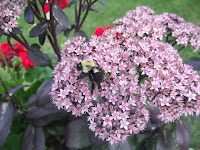
Ah, September - best weather of the year here in Chicagoland. After today, temperatures will be moderate, the humidity will lessen, and the sky will seem bluer. The only thing to spoil the perfection of a Northern Illinois September is the presence of yellow jackets. No barbeque, picnic, or outdoor cafe can be enjoyed, what with the swatting away of these nasty pests. Don't even think about drinking from an open pop can.

I do not confuse them with the bees, however. I consider myself lucky that I have both bumblebees and honeybees. It seems the bees love sedum flowers the most. This is Sedum 'Black Jack,' a disappointing dark-leaved form. The leaves crack and discolor in sunlight, which they need to darken. At least it looks good from a distance.
In the shade garden, native wildflowers start a different kind of show, with the dark blue ripening berries of Polyganatum biflorum

and the dark crimson berries of the Spikenard, Aralia racemosa. I should be afraid of this plant, as it is reputed to get as large as 10 feet, but I trust in my incredibly well-drained soil to rein it in to a manageable 3 feet.

Even with all the rain this summer, the Aralia is still stunted. Of course, that may be because I broke off half of it accidently in Spring. My favorite fall berries are the bright red ones of Smilacina racemosa, seen here with Hosta lancifolia. Ordinarily, I would not pair red with lavender, but it does not see a jarring combination with these two.

Soon the foliage of the Smilacina and the Polyganatum with turn a glorious yellow, setting off those berries brilliantly, before collapsing in a mushy heap.
I haven't seen the bunny around recently. Maybe it drowned in the flood (heh, heh), or, more likely, it left to find food that didn't smell or taste bad. Thank you Plantskkyd.